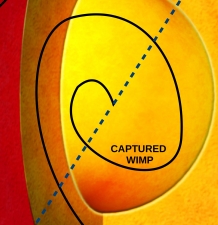K. Frankiewicz has won an award for a poster about searching for a dark matter signal in Super-Kamiokande
12-06-2018
At the beginning of June, during the „Neutrino 2018” conference in Heidelberg, young scientists were given awards in a poster session. Professor Ewa Rondio, the scientific director at the NCBJ, reports: „There were altogether almost 400 posters. More than 200 participated in the competition and a poster from Poland, from NCBJ won. The author is Katarzyna Frankiewicz, who has just submitted her PhD thesis. The poster contains partial results from her PhD thesis and its subject is search for dark matter annihilation in the interior of the Earth. The prize Was funded by the Hamamatsu company and awarded by prof. Kajita – Nobel laureate from 2015".
The poster and the competition presentation can be found in the files attached at the end of this article.
Below we present a popular explanation intended for those with lesser knowledge on this subject.
There is a widespread belief among physicists, that the matter that we have learned about through our senses and with help of our detectors is just a small fraction of entire matter which fills the Universe. About existence of dark matter of an unknown type, which only gravitationally interacts with the matter known to us, convince us quite precise astronomical observations. We expect that because this matter has gravitational capabilities, the famous Einstein formula applies to it as well. If dark matter annihilated away (there are hypothesis that some particles of dark matter are their own antiparticles), then the resulting energy could also change into known to us particles, which are observable.
Such annihilation could take place inside the Earth, where dark matter should be drawn by gravity. Collision (gravitational) of dark matter particles with ordinary matter atom nuclei should slow down the first ones and on one hand „imprison” them inside the Earth but on the other hand it should increase a chance of annihilation (because slow objects annihilate „more willingly” when they meet their anti-partner).
The greatest hope for detection of dark matter annihilation signal in the interior of the Earth is associated with neutrinos. They are almost massless, uncharged, very weakly interacting with nuclei and atoms, but they interact, which allows them to be observed. The point is that annihilation products (primary or secondary) must reach our detectors from inside the Earth, and only very penetrating neutrinos have a chance to do so. Currently, the most powerful neutrino detector is the Super-Kamiokande detector operating in Japan. Katarzyna Frankiewicz from the Warsaw neutrino group analyzed data collected by this detector and presented analysis results in Heidelberg. Ms Frankiewicz showed that in the collected data no signal can be seen that could be attributed to dark matter annihilation inside the Earth. Despite negative results, obtained information is very valuable, because we learnt from it that one of the promising scenarios for detecting dark matter, does not lead unfortunately to the goal with currently available detectors levels of sensitivity. The author put a huge effort into conducting her analysis and showed great care in her work. This has also been appreciated.





